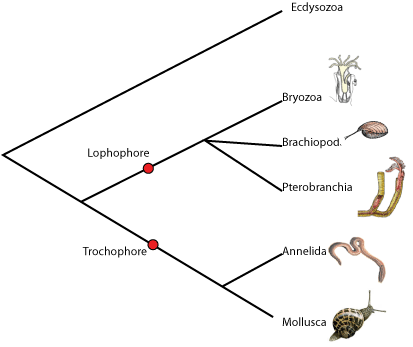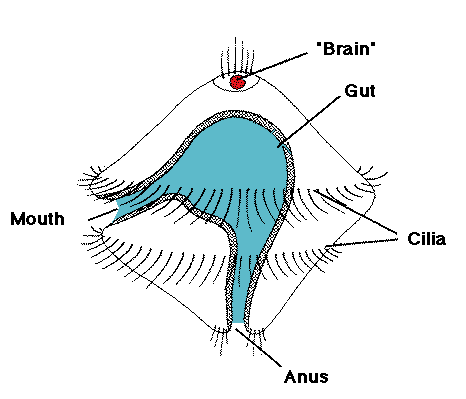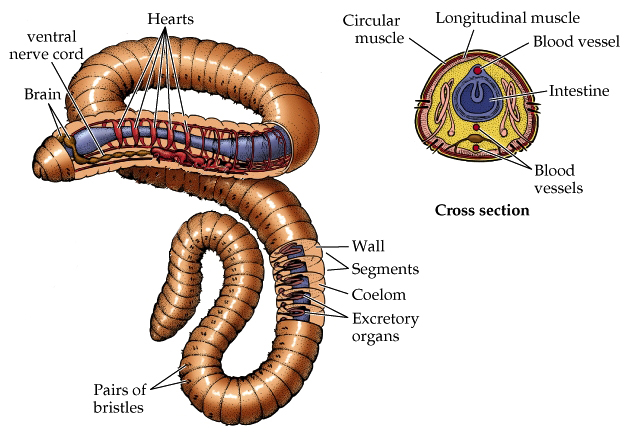What Makes Lophotrochozoa Different From Other Animal Clades
The Protostomes are divided into two groups:
ane. The Lophotrochozoa - which includes the segmented worms, molluscs, lophophorates and several smaller phyla.
2. The Ecdysozoa - which includes the arthropods and several other phyla that periodically molt.
Lophotrochozoa
The name Lophotrochozoa comes from the names of the larval type of the two major animal groups included: the Lophophorata and the Trochozoa.

Trochozoa
The Trochozoa contain many worm-like forms, including the segmented worms (Phylum Annelida) but it too includes the Mollusca (snails, squid, octopods, clams, etc). Information technology might seem strange at first to group earthworms and squid together. They don't expect much akin as adult but many annelids and molluscs share patterns of development in early embryonic stages. When these larvae hatch, each is a microscopic swimmer known as a trochophore larva:

The larvae of these two groups is about identical: with ii bands of cilia effectually the middle that are used for swimming and for gathering food, and at the "acme" is a cluster of longer cilia.
The annelids are the segmented worms (earthworms, leeches, and polychaetes).
In annelids all of the trunk, except the central nerve tracts, principal claret vessel, and digrestive tract are segmented.
Each segment is, express by septa dividing it from neighbouring segments, and has a fluid-filled coelom. Structures such every bit the excretory, locomotory and respiratory organs are generally repeated in each segment. Segments are formed sequentially in annelids and are established during development from growth zones located at the posterior cease of the trunk; and then the youngest segment in the body of an annelid is always the most posterior. The only parts of the annelid body that are not segmental are the head and a terminal post-segmental region called the pygidium.
Segments together with chaetae allow more efficient locomotion and permits specialization of body parts.
More efficient locomotion: Each segment has its ain separate set up of muscles (run circular and longitudinal in each segment; no cross-striations) that can curve or stretch each segment independently.
In Annelids, the nervous organization consists of a "brain" or dorsal ganglion and two circumpharyngeal nerve cords that course down the ventral surface of the body.
The body is covered in thin, flexible, permeable chitinous cuticle that stretches as the animal grows.
Larger torso size means more organ systems.

Annelids probably originated in the Precambrian but the kickoff definite fossils are known from the Cambrian (the primeval role of the Proterozoic) fossil deposites in Canada known as the Burgess Shell.
Annelida are into three major groups; Polychaeta (marine worms), Oligochaeta (earthworms etc.) and Hirudinea (leeches). Earthworms and leeches are the familiar annelids for near people, but polychaetes incorporate the majority of the diversity of Annelida and are institute in nearly every marine habitat, from intertidal algal mats downwards.
Phylum Mollusca
The molluscs include a variety of familiar animals such every bit snails , clams , abalone, octopus and squid. There are almost seventy,000 described species within this phylum.

The coelom is reduced to a pocket-size space around the hearts , gonads , and metanephridia ( kidney -like organs). The primary body cavity is a claret-filled sac surrounding the organs.
Molluscs have a pall, which is a fold of the outer pare that produces the calcium carbonate shell, and a muscular foot that is used for motion. Many have a feeding structure, the radula , mostly composed of chitin .
There are a variety of body forms:
The Molluscs are thought to have evolved just before the Cambrian and diversified throughout the early Proterozoic. 1 of the major groups, the Ammonites, were major predators in the sea earlier the ascent of jawed fish.
 | AMMONOIDS are similar to the modern chambered nautilus. These extinct marine animals thrived in the Paleozoic and Mesozoic Eras, some 400 to 65 1000000 years agone. Ammonites were able to swim, thanks to the unique construction of their shell, which was divided into a series of air chambers. The air in the chambers provided buoyancy for the animal to float; like modern cephalopods, they probably moved through the h2o using jet propulsion. Because ammonites lived exclusively in marine environments, their presence also indicates the location of prehistoric seas. |
Lophophorates
By and large marine; sedentary or sessile.
Because they are sessile, y'all might gues that they are filter feeders and you would exist right -- they have a fix of ciliated tentacles (the lophophore) that environment a U-shaped digestive tract:
The Lophophorates include:
Source: https://www2.gwu.edu/~darwin/BiSc151/Lopho/Lophotrochozoa.html
Posted by: churchaceeakell.blogspot.com

0 Response to "What Makes Lophotrochozoa Different From Other Animal Clades"
Post a Comment